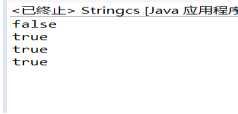04-课堂作业总结归纳
Posted
tags:
篇首语:本文由小常识网(cha138.com)小编为大家整理,主要介绍了04-课堂作业总结归纳相关的知识,希望对你有一定的参考价值。
1、请运行以下示例代码StringPool.java,查看其输出结果。如何解释这样的输出结果?从中你能总结出什么?
源代码:
public class StringPool {
public static void main(String args[])
{
String s0="Hello";
String s1="Hello";
String s2="He"+"llo";
System.out.println(s0==s1);//true
System.out.println(s0==s2);//true
System.out.println(new String("Hello")==new String("Hello"));//false
}
}
第一个so==s1和第二个s0==s2比较的都是字符串的内容(java语言定义“+”运算符可用于两个字符串的连接操作),所以是true。第三个用new创建了两个对象,当直接使用new关键字创建字符串对象时,虽然值一致(都是“Hello”),但仍然是两个独立的对象。
2、

为什么会有上述的输出结果?从中你又能总结出什么?
给字串变量赋值意味着:两个变量(s1,s2)现在引用同一个字符串对象“a”!
String对象的内容是只读的,使用“+”修改s1变量的值,实际上是得到了一个新的字符串对象,其内容为“ab”,它与原先s1所引用的对象”a”无关,所以,s1==s2返回false;
代码中的“ab”字符串是一个常量,它所引用的字符串与s1所引用的“ab”对象无关。
String.equals()方法可以比较两个字符串的内容。
3、请查看String.equals()方法的实现代码,注意学习其实现方法。
源代码:
public class StringEquals {
/**
* @param args the command line arguments
*/
public static void main(String[] args) {
String s1=new String("Hello");
String s2=new String("Hello");
System.out.println(s1==s2);
System.out.println(s1.equals(s2));
String s3="Hello";
String s4="Hello";
System.out.println(s3==s4);
System.out.println(s3.equals(s4));
}
}

4、String类的方法可以连续调用:
String str="abc";
String result=str.trim().toUpperCase().concat("defg");
请阅读JDK中String类上述方法的源码,模仿其编程方式,编写一个MyCounter类,它的方法也支持上述的“级联”调用特性,其调用示例为:
MyCounter counter1=new MyCounter(1);
MyCounter counter2=counter1.increase(100).decrease(2).increase(3);
public class MyCounter
{public static void main(String[] args)
{ String s="aqz";
String result=s.trim().toUpperCase().concat("qwe");
System.out.println(result);
}
}
5、整理String类的Length()、charAt()、 getChars()、replace()、 toUpperCase()、 toLowerCase()、trim()、toCharArray()使用说明
Length():获取字串长度
charAt():获取指定位置的字符
getChars():获取从指定位置起的子串复制到字符数组中
replace():子串替换
toUpperCase()、 toLowerCase():大小写转换
trim():去除头尾空格
toCharArray():将字符串对象转换为字符数组
length():public int length()//用来求字符串长度
String s=”dwfs”;
System.out.println(s.length());
charAt():public charAt(int index)//index 是字符下标,返回字符串中指定位置的字符
String s=”Hello”;
System.out.println(s.charAt(3));
getChars():public int getChars()//将字符从此字符串复制到目标字符数组
String s= "abc";
Char[] ch = new char[8];
str.getChars(2,3,ch,0);
replace():public int replace()//替换字符串
String s=”****”;
System.out.println(s.replace(“****”,”***”));
toUpperase():public String toUpperCase()//将字符串全部转换成大写
System.out.println(new String(“hello”).toUpperCase());
toLowerCse():public String toLowerCase()//将字符串全部转换成小写
System.out.println(new String(“HELLO”).toLowerCase());
trim():public String trim()//是去两边空格的方法
String x=” a bc ”;
System.out.println(x.trim());/
toCharArray(): String x=”abcd”;// 将字符串对象中的字符转换为一个字符数组
char myChar[]=x.toCharArray();
System.out.println(“myChar[1]”+myChar[1]);
以上是关于04-课堂作业总结归纳的主要内容,如果未能解决你的问题,请参考以下文章